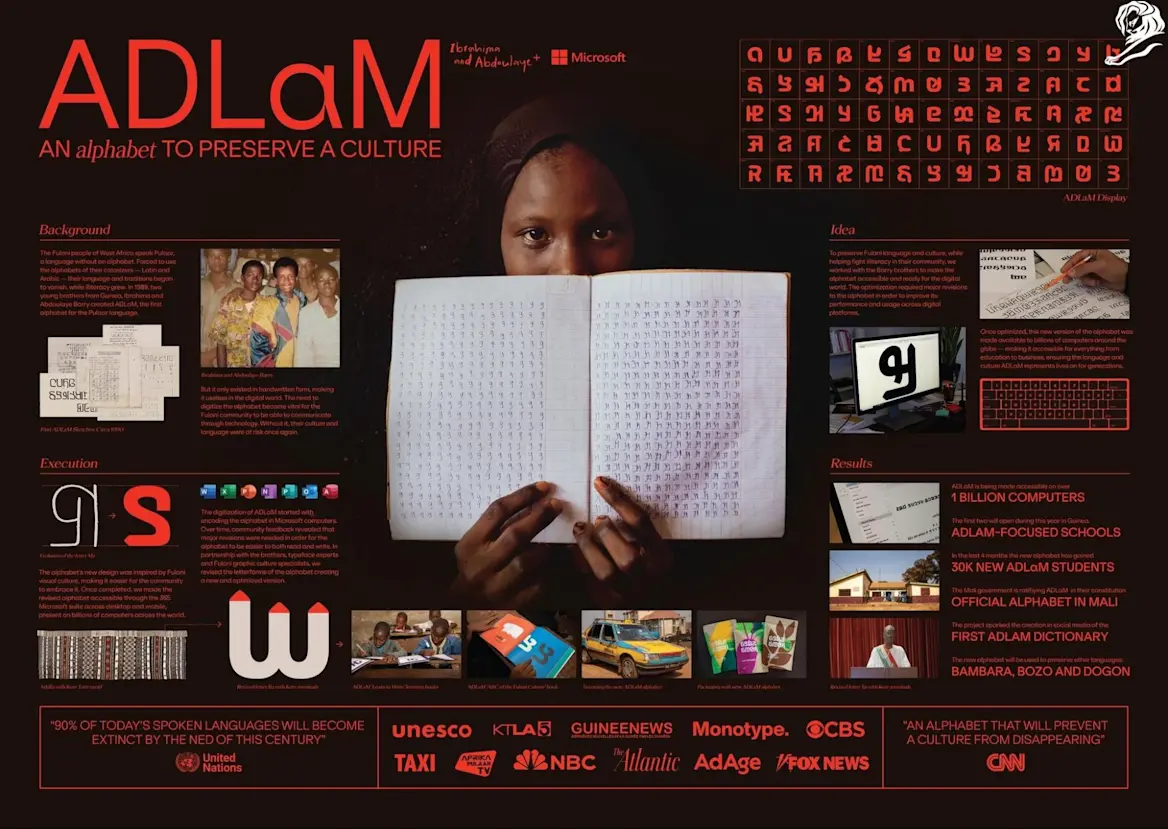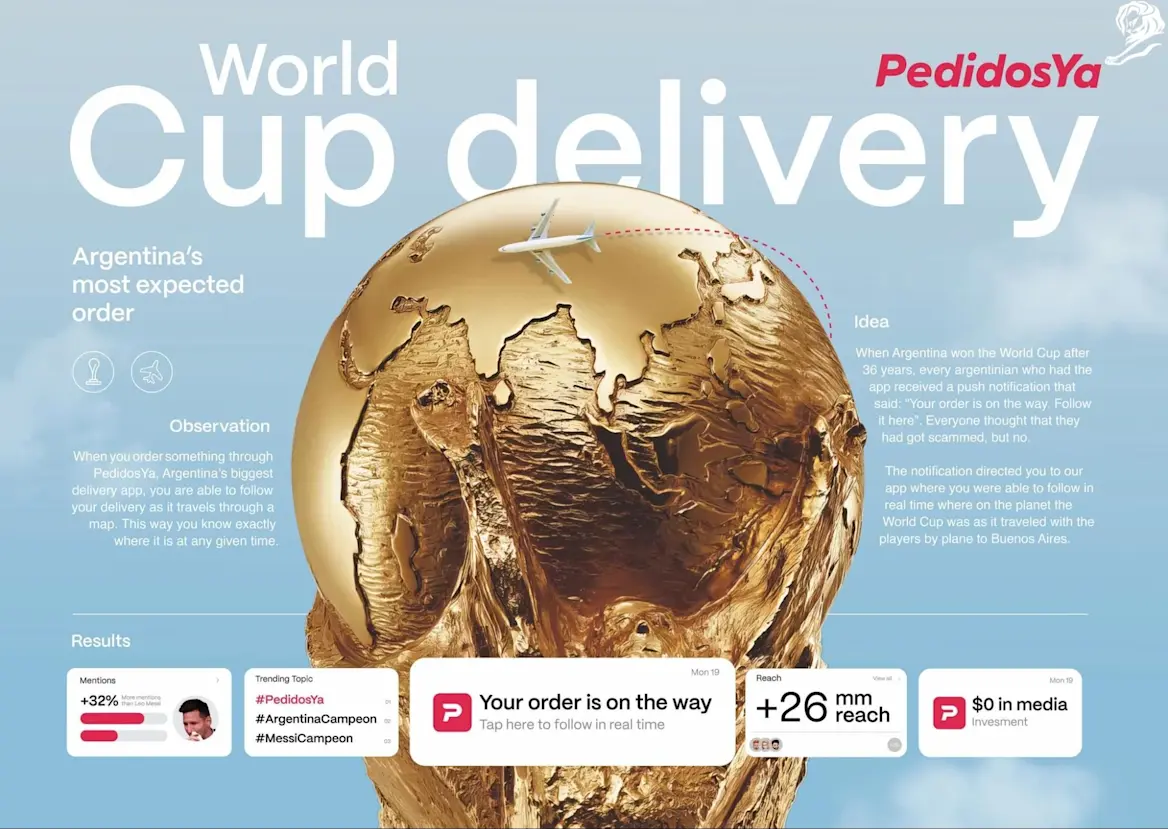Creative Effectiveness Lions
The Creative Effectiveness Lions celebrate the measurable impact of creative work.
Introduction

The work should demonstrate how an effective strategy rooted in creativity has met its chosen business objectives, generated positive customer outcomes and driven sustainable business impact over time.
The history of the Creative Effectiveness Lions
Launched in 2011, the Creative Effectiveness Lions are defined by a demanding entry process involving a detailed dissection of the work, focused largely on articulating demonstrable results. It’s a requirement that often results in agencies and their clients collaborating on submissions – a process that is educational in itself.
Initially this Lion was open only to shortlisted and winning entries from the previous year. However, it was acknowledged that the business impacts of creativity take longer to be proven over time and so the eligibility period was extended to work that won or was shortlisted within the previous 3 years.
In 2021 the Lion and its entry form were redesigned to reflect the principles of the Creative Effectiveness Ladder LIONS created in collaboration with WARC.
What kind of work can be entered?
The Creative Effectiveness Lions is open to any organisation that has won or been shortlisted for a Cannes Lions Award in 2022, 2023 or 2024 that can demonstrate that their creative work has driven results and achieved commercial success for a brand.
The entry can come from a company credited on the shortlisted or winning work. So even if you were not the original entrant, because you were involved and credited on the work you can submit what has happened since winning as part of a Creative Effectiveness entry.
What’s the Jury looking for?
The work should demonstrate how a well-crafted, creativity-driven strategy has successfully aligned with its specific business objectives, creating both immediate and lasting value. This involves showcasing how creative insights and innovative thinking have attracted and engaged customers, building trust and loyalty that drives continued positive outcomes.
Importantly, the strategy should not only meet short-term goals but also demonstrate a sustainable impact on the business over time, reinforcing the value of creativity as a long-term investment.

ADLAM: AN ALPHABET TO PRESERVE A CULTURE | MICROSOFT | MCCANN, NEW YORK | SILVER, CREATIVE EFFECTIVENESS LIONS | 2024
The Categories

A. Creative Effectiveness: Sectors
Work in this section should focus on effectiveness achieved in a particular sector, and whether the work achieved or exceeded its objectives and goals.
The same entry can be submitted only once in this section.
B. Market
Work in this section should demonstrate how it enabled the brand to effectively achieve their objectives in a chosen market.
C. Brand Challenges & Opportunities
Work in these categories should focus on the brand challenge or opportunity identified. The work should explain its strategic response, as well as specific channels and touchpoints chosen and why.
D. Long-Term Brand Platform
Eligibility

To be eligible your work must have won or been shortlisted at Cannes Lions in 2022, 2023 or 2024.
Exception:
- To be eligible for ‘D01 Long-Term Brand Platform’, the work must include at least three distinct campaigns within a broader brand strategy that has been in the market for at least three years. Additionally, at least one campaign must have won or been shortlisted at Cannes Lions in 2022, 2023, or 2024.
Is there a limit to how many times I can enter?
The same piece of work can be entered up to four times in Creative Effectiveness.
Exception:
- The same piece of work may only be entered once in ‘A. Creative Effectiveness: Sectors’.

WORLD CUP DELIVERY | PEDIDOSYA | GUT, BUENOS AIRES | GOLD, CREATIVE EFFECTIVENESS LIONS | 2024
Previous Winners

It Has To Be Heinz
Cannes Lions 2024 Grand Prix Rethink, Toronto / Heinz Ketchup / 2024
Over the course of five years, Heinz rebuilt and reignited consumer love for Heinz Ketchup with a series of strategic campaigns, involving unique ideas and audience engagement, which recentered the brand and the product as an icon. The work resulted in a 12% increase in global Heinz Ketchup sales growth compared to year-over-year numbers since 2019.
IT HAS TO BE HEINZ | HEINZ KETCHUP | RETHINK, TORONTO | GRAND PRIX, CREATIVE EFFECTIVENESS LIONS | 2024
Why the work won
The Creative Effectiveness Jury awarded this work the Grand Prix for exemplifying best-in-class creative strategy and execution. Jury President Harjot Singh commended it as a "textbook example" of excellence, noting that it skillfully avoided the pitfalls of constant reinvention, focusing instead on refining and optimising an already strong foundation. This approach enabled the work to stay relevant and engaging for current audiences while also establishing an enduring brand presence.
By balancing innovation with consistency, the campaign demonstrated how creative effectiveness can achieve both timely appeal and lasting impact, striking the rare “sweet spot” between contemporary relevance and timeless resonance.

IT HAS TO BE HEINZ | HEINZ KETCHUP | RETHINK, TORONTO | GRAND PRIX, CREATIVE EFFECTIVENESS LIONS | 2024
Inside the Jury Room: Creative Effectiveness Lions
To hear more from the Jury and how they decided on the winning work, check out the video below.
Entries & Judging

What are the judging criteria?
A number of criteria will be considered during judging, weighted as follows: 25% idea; 25% strategy; 50% impact and results.
What do I need to provide with my entry?
To enter, you’ll need to complete an online entry form, which can be found on the Cannes Lions entry site. In the ‘Written Explanation’ section, you’ll be asked to provide the Jury with everything they need to know about your work.
You’ll also be able to submit optional supporting materials to provide additional context with your entry.
Subtitles are highly recommended on all case films, films, demo films and original content.
Detailed information outlining the entry process can be found on A Guide to the Cannes Lions Awards.
What if I don’t have all the details right away?
Don’t worry – you can fill in the form in any order and save your progress at any time while it’s still in the pending stage. However, please only check out when your entry is 100% complete as no changes can be made to your entry once you’ve clicked “Submit” and “Checkout”.
The Written Submission

Here’s the questions you’ll be asked regarding your work.
To start your entry to the Creative Effectiveness Lions, go to our Awards page.
The Jury will refer to the written explanation you provide throughout the judging process. Our advice is to provide as much relevant detail as possible.
When answering the following questions keep the main element you’re trying to celebrate in mind (e.g. the storytelling, the strategy, the craft, the use of data).
The bullet points under each question are prompts designed to guide your thinking, based on the factors the jury will be considering when reviewing your work. You might not need to use them all, and that’s totally fine. They’re there to help you consider what’s most important in your work.
Questions
Category Specific Questions

THE LAST PERFORMANCE | PARTNERS LIFE | SPECIAL AUCKLAND | BRONZE, CREATIVE EFFECTIVENESS LIONS | 2024
Contact us

Everything you need to know to enter
For more detailed information on how to use the entry site, craft a compelling submission or submit your work we have a whole range of resources.
From Entry Guides that give you a step-by-step overview of the entire process to the Entry Kits that provide all the detailed rules and requirements for each and every category.

We are here to help
As Awards Experts, we know the Lions inside out. We can help with:
- Sharing the updates to the Awards for 2025
- Offering best-practice advice on how to craft a compelling entry
- Discussing your work and relevant categories
- Scheduling regular catch-ups to answer any questions that arise throughout the entry process.
Whether you have a specific query or would like expert advice, get in touch today.
Email: awards@canneslions.com Helpline: +44 0 20 7046 1155